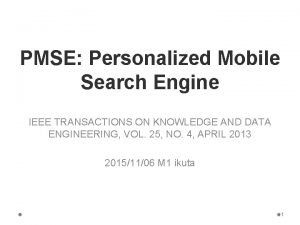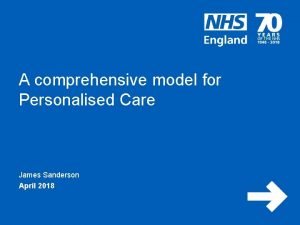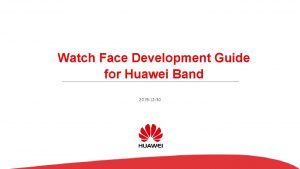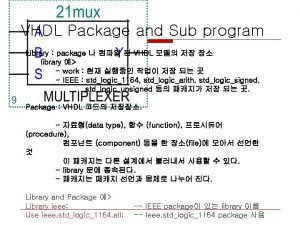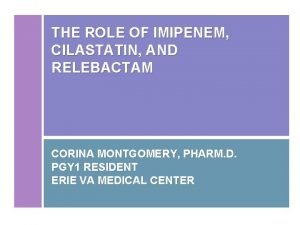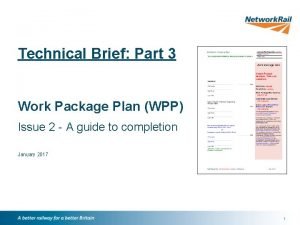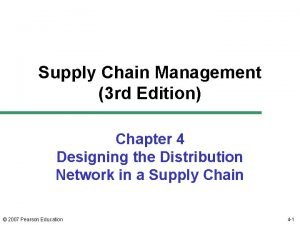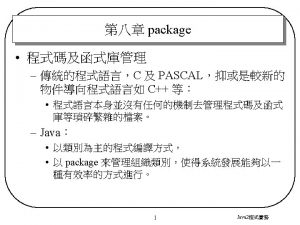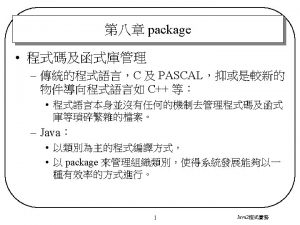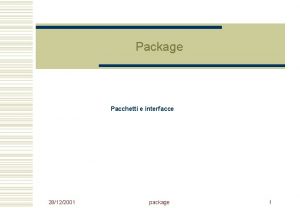Eo L Educational Package 4 Lesson 1 Personalised

















- Slides: 17

Eo. L Educational Package 4 – Lesson 1: Personalised Care and Support Planning (PCSP) September 2019 NHS England NHS Improvement

Lesson 1 Aim: To demonstrate clarity about what Personalised Care and Support Plan (PCSP) is, and is not, and how this fits with other palliative and end of life care-related planning tools, e. g. Re. SPECT, Advance Care Planning (ACP), etc. Content: • Why is care planning important? • Definition of PCSP • Demonstrate how fits in with other End of Life (Eo. L) planning tools 2 | Lesson 1

Why is taking a personalised approach to care planning important? 3 |

Why involve people in their own health and care? • National surveys tell us that over 40% of people want to be more involved in decisions about their care. Similarly 40% of people living with long term conditions want more support to manage their health and wellbeing on a day to day basis. • By involving people in decisions about their health and care we will improve health and wellbeing, improve the quality of care and ensure people make informed use of available healthcare resources. • Personalised care and support planning is a systematic way of ensuring that individuals living with one or more long term condition are supported through proactive conversations, with their clinician or health and care professionals. These conversations should focus on what matters most to that individual (their personal goals) and the support they need to manage their health and wellbeing. It should be a process of sharing information, identifying medical and non-medical support needs, discussing options, contingency planning, setting goals, documenting the discussion and monitoring progress through regular review. 4 | Lesson 1

Definition of PCSP • Personalised Care and Support Planning is a series of facilitated conversations in which the person, or those who know them well, actively participates to explore the management of their health and well-being within the context of their whole life and family situation. • The process recognises the person’s skills and strengths, as well as their experiences and the things that matter the most to them. It addresses the things that aren’t working in the person’s life and identifies outcomes and actions to resolve these. 5 | Lesson 1

Fundamentally it’s about………. A different conversation, starting with what matters And recognising people as equals and experts in their own lives & 6 | Lesson 1

Key Features - Perspective – this is a way of ‘seeing people’ and attitude towards them that is fundamental to good Personalised Care and Support Planning. The changed relationship and different conversation will mean that the person: • is empowered and builds knowledge, skills and confidence. • experiences hope and feels confident that the process and the plan will deliver what matters most to them. • is central in developing their Personalised Care and Support Plan and will agree who is involved. • is seen as a whole person within the context of their whole life, valuing their skills, strengths, experience and important relationships. • is valued as an active participant in conversations and decisions about their health and well being. 7 | Lesson 1

Key Features - Process – this is the overall process of personalised care and support planning. A good Personalised Care and Support Planning process will mean that the person: • has the time and support to develop their plan in a safe and reflective space. • is able to access information and advice that is clear and timely and meets individual information needs and preferences. • feels prepared, knows what to expect and is ready to engage in planning supported by a single, named coordinator. • is listened to and understood in a way that builds trusting and effective relationships with key people. • is able to agree the health and well-being outcomes (and learning outcomes for children and young people with education, health and care plans) they want to achieve, in dialogue with the relevant health, education and social care professionals. • has the chance to formally and informally review their personalised care and support plan. • has the chance to make informed decisions about their own treatment through shared decision making discussions. 8 | Lesson 1

Key Features - Plan – this is what a good plan looks like. A Personalised Care and Support Plan: • is a way of capturing and recording conversations, decisions and agreed outcomes in a way that makes sense to the person. • should be proportionate, flexible and coordinated and adaptable to a person’s health condition, situation and care and support needs. • should include a description of the person, what matters to them and all the necessary elements that would make the plan achievable and effective. 9 | Lesson 1

Long Term Plan (LTP) Metrics Personalised Care and Support planning is one of 30 LTP metrics. Paragraph 1. 42 in the LTP states “With patients, families, local authorities and our voluntary sector partners at both a national and local level, including specialist hospices, the NHS will personalise care, to improve end of life care”. It continues “By rolling out training to help staff identify and support relevant patients, we will introduce proactive and personalised care planning for everyone identified as being in their last year of life”. The count includes the total number of personalised care and support plans (new PCSP completed or existing PCSP reviewed) during the financial year to date. 10 | Lesson 1

5 Key Criteria The 5 areas below are the key criteria for counting PCSPs. All 5 of these criteria need to be in place for a local PCSP to be counted. 1. People are central in developing and agreeing their personalised care and support plan including deciding who is involved in the process. 2. People have proactive, personalised conversations which focus on what matters to them, paying attention to their needs and wider health and wellbeing. 3. People agree the health and wellbeing outcomes they want to achieve, in partnership with the relevant professionals. They have the chance to make informed decisions about their own treatment through shared decision making processes. 4. Each person has a sharable, personalised care and support plan which records what matters to them, their outcomes and how they will be achieved. 5. People are able to formally and informally review their personalised care and support plan. 11 | Lesson 1

How does PCSP fit into the Ambitions Framework? I, and the people important to me, have opportunities to have honest, informed and timely conversations and to know that I might die soon. I am asked what matters most to me. Those who care for me know that and work with me to do what’s possible. I live in a society where I get good end of life care regardless of who I am, where I live or the circumstances of my life. I get the right help at the right time from the right people. I have a team around me who know my needs and my plans and work together to help me achieve them. I can always reach someone who will listen and respond at any time of the day or night. 12 | Lesson 1

How PCSP fits in with other Eo. L planning tools 13 | Lesson 1

ü People are central in developing and agreeing their PCSP. ü People have proactive, personalised conversations which focus on what matters to them. ü People agree the health and wellbeing outcomes they want to achieve, in partnership with the relevant professionals. ü Each person has a sharable personalised care and support plan. ü People have the opportunity to formally and informally review their care plan. Reference Resuscitation Council (UK) - Re. SPECT 14 | Lesson 1

Advance Care Plan (ACP) ü People are central in developing and agreeing their PCSP. ü People have proactive, personalised conversations which focus on what matters to them. ü People agree the health and wellbeing outcomes they want to achieve, in partnership with the relevant professionals. ü Each person has a sharable personalised care and support plan. ü People have the opportunity to formally and informally review their care plan. Reference NEo. LC Improving end of life care – Advanced Care Planning: It all ADSE up 15 | Lesson 1

Electronic Palliative Care Coordination System (EPa. CCS) ü People are central in developing EPa. CCS facilitates a structured care planning conversation. EPa. CCS aim to provide up-to-date key information about patients believed to be in the last year of their life in order to improve communication and coordination and ensure that all those involved in a patient's care aware of their wishes, preferences and advance care plan. A number of trusts offer printed copies of the information contained within EPa. CCS to patients. Reviews normally occur after a significant change in the patients condition. and agreeing their PCSP. ü People have proactive, personalised conversations which focus on what matters to them. ü People agree the health and wellbeing outcomes they want to achieve, in partnership with the relevant professionals. ü Each person has a sharable personalised care and support plan. ? People have the opportunity to formally and informally review their care plan. . Reference BMJ – Crash course in EPa. CCS: 8 years of successes and failures in patient data sharing to learn from The End of Life Partnership - EPa. CCS 16 | Lesson 1

Key learning • PCSP conversations should be a process of sharing information, identifying medical and non-medical support needs, discussing options, contingency planning, setting goals, documenting the discussion and monitoring progress through regular review. • It is about a different conversation, starting with what matters and then recognising people as equals and experts in their own lives. • PCSP is one of 30 LTP metrics - the LTP stipulates that “proactive and personalised care planning will be introduced for everyone identified as being in their last year of life”. • PCSP is aligned to Ambitions 1, 2 and 4. • PCSP may encompass, but is not limited to, advance care planning. PCSP is essentially an umbrella term. Lesson 2 aims to demonstrate skills and behaviours which enable the process of PCSP to be initiated and conducted in a way that is person-centred and supportive of the person. 17 | Lesson 1
 Personalized mobile search engine ieee paper
Personalized mobile search engine ieee paper Comprehensive model of personalised care
Comprehensive model of personalised care Personalised care operating model
Personalised care operating model Comprehensive model of personalised care
Comprehensive model of personalised care Medolac
Medolac General motors
General motors James sanderson nhs
James sanderson nhs It’s educational – lesson 5
It’s educational – lesson 5 Graphic communications definition
Graphic communications definition Huawei watch face development
Huawei watch face development Csar package format
Csar package format Package vhdl
Package vhdl Java net package
Java net package Corina montgomery
Corina montgomery Network rail wpp template
Network rail wpp template Tbilisi tour packages
Tbilisi tour packages How to maintain housing society accounts in tally
How to maintain housing society accounts in tally Disadvantage of distributor storage with carrier delivery
Disadvantage of distributor storage with carrier delivery
